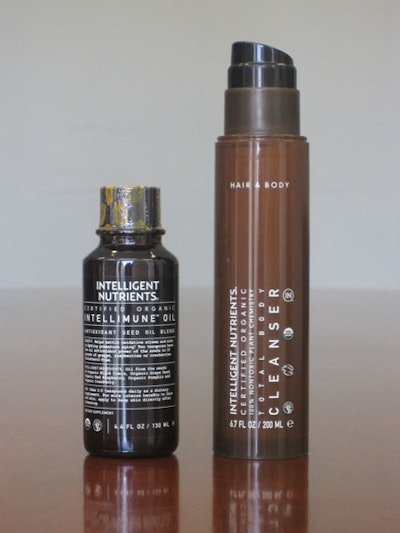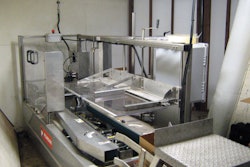Implementations of brand-protection solutions can be found in products as varied as shampoo, high-end balsamic vinegar, and wine. But if any group of packaged goods manufacturers knows what it’s like to do battle with today’s counterfeiters and gray marketeers, it’s those who market personal care products through exclusive agreements with salons and specialty retailers.
Management at one such company, Intelligent Nutrients, decided to waste no time in including an authentication component in their packaging. This Minneapolis-based start-up sells a certified-organic line of personal care products such as pure-seed face serum that sells for $60 per 1.7-oz bottle. From the day IN’s product was made available to consumers, their bottles, cartons, cases, and pallets have all carried the unique identification numbers that are tied into the DATT (Digital Authentication, Track and Trace) system from Verify Brand LLC (www.verifybrand.com).
“Diversion in the salon channel and other channels we move through has become such a problem that we wanted a way to identify where our product was at any given point in the chain, from manufacturing to consumers in their homes,” says Rick Goldberg, directing manager at IN. “DATT emerged from the pharmaceutical industry, where certain drugs have to be tracked every step of the way. It’s an extremely effective defense against diverters and counterfeiters.”
For each bottle of IN certified-organic health and beauty product, Verify Brand generates a unique code that gets printed in both alphanumeric and 2D bar-code format on each bottle’s label. Corrugated cases and pallets of cases also get unique codes, and in each case, the codes establish a parent/child relationship. So the case code identifies the case as the parent of all the bottles it holds, and the pallet code identifies the pallet as the parent of all the cases it holds.
When a pallet reaches a Distribution Center, the pallet code is scanned. The Verify Brand database records this pallet code so that IN knows for certain that the pallet, its 150 corrugated shippers, and the 1,800 bottles in those shippers have been received by Distributor A and are available for valid sale to customers. As customer orders are picked from Distributor A, each case of bottles is scanned so that the database knows which unique bottle codes have been sent to which customers. If IN finds one of its bottles has been diverted to eBay or a Kmart store, the identity of the party responsible for this breach of contract is easily revealed, thanks to the unique codes generated and tracked by the DATT system.
A Web portal set up by Verify Brand has an investigator interface that lets IN employees scan in the 2D bar code or enter the human-readable alphanumeric code to check it against the central database. The person doing the scanning sees immediately a record of who filled the bottle, where it was packaged, and what the lot number, batch number, and expiration dates are.
Salons that are authorized to carry IN’s products can access a separate Web portal by entering a user name and password. They also enter the unique alphanumeric code that’s on a bottle, and if the code is not authentic, they are presented with a form asking them to identify the distributor from whom that shipment came.
The same Web portal accessed by authorized salons can also be accessed by consumers. Not only does the unique code enable them to verify the authenticity of their containers, but they can also redeem purchase points that can be used to win gifts. When a consumer enters the unique code on a bottle, a code-check mechanism built into the Verify Brand software automatically converts that code’s status from “active” to “redeemed” to prevent consumers from redeeming a code more than once.
“DATT permits us to engage the consumer at two levels,” says Goldberg. “First, we give them the unique code to verify the authenticity of their container and the product in it. And second, because they are registering their purchase, they build up points that can be exchanged for gifts.”
And the cost of implementing this track-and-trace functionality? Goldberg estimates it’s about 20 cents/bottle. But he expects that to come down, “maybe significantly,” as volumes increase.
Transition underway
Goldberg’s comment about engaging the consumer is one being heard increasingly these days where brand-protection packaging based on track-and-trace technology is concerned.
It’s not that the primary purpose of the technology—authentication—has been subverted in any way. But users of track-and-trace packaging solutions are finding that there is a bonus benefit to be had where engaging the consumer is concerned.
Consider the high-end balsamic vinegar produced by Acetaia San Giacomo of Italy. It retails for $35 to $45 per 25-mL bottle. Since 2008 the firm has been using a brand-protection and traceability solution from Certilogo (www.certilogo.com). Certilogo software generates unique 12-digit codes according to Acetaia San Giacomo’s needs. The label printer then prints the codes on the labels that go on the bottles.
At the store where the balsamic vinegar is sold, consumers can verify the authenticity of the bottle and its contents by sending a text message via their cell phone to a number set up by Certilogo. If the number they send in is not authentic, they are notified immediately.
Consumers can also navigate the Web site accessed by the unique code to learn more about the product, where it comes from, what food critics are saying about it, how to cook with it, and so on. According to Acetaia San Giacomo’s Andrea Bezzecchi, it’s the Certilogo system’s communications capability that he values most. As we saw in the case of Intelligent Nutrients, the unique code on the label becomes a way for packaged goods companies to engage the consumer. And because it’s all Web-based, it’s infinitely dynamic as opposed to static information in print somewhere that can only be changed at considerable cost and after considerable delay.
Another manufacturer in Italy using the Certilogo solution is Tuscany’s Piccolomini d’ Aragona vineyards. This is the third year the winery has deployed this technology. It’s interesting to note that it is used on the firm’s entire range of wines, from those that sell for $13 to those fetching $100. Consumer inquiries via text messaging or the Internet have come in from 25 countries.
This winery also graces its bottles with an additional authentication element: an Optically Variable Device (OVD) called Trustseal from Kurz (www.kurz.de). OVD is the name given to iridescent security elements that exhibit various optical effects such as movement or color changes. Based as they are on diffractive optical structures, these complex designs are difficult to copy. That’s what makes them so effective in deterring counterfeiters.
“The Kurz label is a passive system to verify the authenticity of the bottle,” says Mauro Zanca, sales director at the winery. “The Certilogo code is a further step that empowers the consumer to not only check if the bottle is authentic, but also to establish a dialogue with us. With this technology, we can communicate whatever information we choose to, including descriptions of the winery and of our wines.”
Animal healthcare
Manufacturers serving the salon scene and the specialty foods market aren’t the only ones focused on brand protection these days. Drug makers, too, have been fighting the good fight for years now, and that includes companies that make drugs for animal healthcare.
“Product diversion is growing increasingly common in animal health,” says Albert Ahn, president of AB Science USA. “Products meant to be sold only by veterinarians are showing up for sale in mainstream retail outlets or online.”
Special promotions from the manufacturers are often at the root of the problem. When vets can purchase product at a deep discount as part of a promotion from a manufacturer, the temptation to resell it to a consolidator who then supplies it to retailers is oftentimes too powerful to resist.
Ahn and his colleagues at AB Science, a start-up company based in Short Hills, NJ, plan to launch what they believe is the world’s first anti-cancer drug for the treatment of mast-cell tumors in dogs. Currently undergoing review by the Federal Drug Administration, the new drug will be in a tablet format packaged in bottles. While a number of brand-protection packaging solutions are being evaluated, says Ahn, it seems likely that some system of item-level serialization with a unique identification number carried in a 2D bar code will be selected.
What about standards
Meanwhile, from the International Organization for Standardization comes an announcement that two new committees have been set up to develop standards for tackling counterfeiting and fraud. ISO/PC 246, “Anti-Counterfeiting tools,” held its first meeting in March. ISO/TC 247, “Fraud countermeasures and controls,” will meet soon.
Behind the formation of these two new committees is the theory that an ISO standard would increase market transparency regarding the reliability and robustness of authentication tools. It would help businesses make an informed choice when selecting the best tools for establishing the authenticity of a product. The standard would also help vendors of anti-counterfeiting systems, whether simple or complex, improve the solutions they offer.
“Specifying performance criteria of authentication devices is crucial at both the national and international level, to nurture greater confidence among consumers, empower and secure the distribution circuits, and help public authorities deploy preventive and punitive measures,” says Jean-Michel Loubry, chair of ISO/PC 246. The committees will look at the entire life cycle of a product to facilitate integration of anti-counterfeiting concepts in product design. Issues to be addressed are
• criteria for data processing and access to data
• interoperability of anti-counterfeiting systems
• capacity to facilitate controls
“The standards produced by [these committees] will provide harmonized, consensus-based, reliable solutions to help prevent the loss of earnings and jobs at companies that are victims of fraud and counterfeiting,” says ISO secretary-general Rob Steele. “They’ll also protect consumers from inadequate and unsafe products.”

















![Xl Touch Scoreboard Screen High Res[39]](https://img.packworld.com/mindful/pmmi/workspaces/default/uploads/2025/12/xl-touch-scoreboard-screen-highres39.JHTycZQYnN.png?auto=format%2Ccompress&fit=crop&h=227&q=70&w=340)







